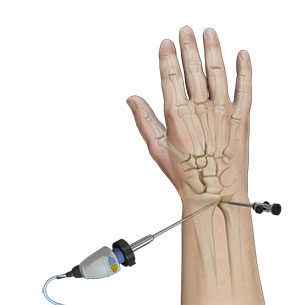
What is Distal Radioulnar Joint Arthritis?
Distal radioulnar joint (DRUJ) arthritis is an inflammatory condition characterized by gradual wearing away of the cartilaginous surface of the radioulnar joint resulting in significant pain, swelling, stiffness, and interference in the functioning of the wrist and/or arm.
The forearm consists of two bones, the radius and ulna. The radius is the larger of the two forearm bones. The region towards the wrist is called the distal end. Distal radioulnar joint (DRUJ) is a pivot type synovial joint located between the radius and the ulna just proximal to the wrist joint and assists in pronation and supination of the forearm. The joint is critical to the working of the forearm as a mechanical unit. The wrist, forearm, and elbow act as an integrated structure to provide a stable, strong and highly mobile support system for proper positioning of the hand and for performing load-bearing activities.
Causes of Distal Radioulnar Joint (DRUJ) Arthritis
Distal radioulnar joint (DRUJ) arthritis may occur from several sources, such as:
- Repetitive injury to the joint
- Previous trauma with joint malformation
- Systemic disease such as rheumatoid arthritis
- Degenerative joint disease such as osteoarthritis
- Gradual wear and tear of the joint
- Congenital anomalies
Symptoms of Distal Radioulnar Joint (DRUJ) Arthritis
Some of the common symptoms of distal radioulnar joint arthritis include:
- Pain and tenderness
- Inflammation and swelling
- Reduced grip strength
- Reduced range of motion
- Popping or clicking sound
- Instability
- Weakness and loss of function of the forearm
Diagnosis of Distal Radioulnar Joint (DRUJ) Arthritis
Your doctor will assess your symptoms, take your medical history, and perform a thorough physical examination of your wrist to check for range of motion and strength. Imaging tests such as X-rays or CT-scans may be ordered for a detailed evaluation of the radioulnar joint to assess the severity of arthritis. Plain x-rays may exhibit bone spurs, narrowing of the joint space, subchondral bone cysts, or deformity. When x-ray findings are negative, CT scans of the DRUJ may divulge information about degenerative changes in the ulnar head.
Treatment for Distal Radioulnar Joint (DRUJ) Arthritis
The treatment options for distal radioulnar joint (DRUJ) arthritis include both nonsurgical methods as well as surgical methods. Your doctor will determine the right option for you based on the severity of the condition.
Nonsurgical Treatment
- Activity Modification: Avoiding activities that trigger symptoms and changing one’s habits
- Ice: Application of ice packs on the joints to decrease swelling and pain
- Physical Therapy: Regular exercise regimen to improve range of motion and strengthen wrist muscles
- Anti-inflammatory Medication: Medications like naproxen and ibuprofen to relieve inflammation and pain
- Cortisone Injection: Cortisone is a very effective anti-inflammatory medicine and long-term pain reliever.
- Orthotics: Use of assistive devices such as splints and braces
Surgical Treatment
Surgical interventions employed for the treatment of distal radioulnar joint (DRUJ) arthritis include:
- Resection Arthroplasty: Arthroplasty is another term for joint replacement. In this method, a portion of the problematic bone is removed to eliminate pain in the radioulnar joint. There are 3 procedures that can be employed under resection arthroplasties, such as the Darrach procedure, hemiresection procedures (there are many variations), and the Sauve-Kapandji procedure.
- Implant Arthroplasty: This is a method of joint replacement that involves replacement of the partial ulnar head, arthroplasty of the total ulnar head, or total arthroplasty of the DRUJ.
- Salvage Procedure: The meaning of salvage is to “save” as much joint and surrounding soft tissue structures as possible. Hence, this method often corresponds to sacrificing forearm motion so as to preserve strength and function. Some of the examples of salvage procedures for the treatment of DRUJ instability include:
- Making a one-bone forearm (OBF), a type of fusion technique
- Wide excision of the distal ulna, a technique that involves removal of a sizeable section of the base of the ulnar bone















